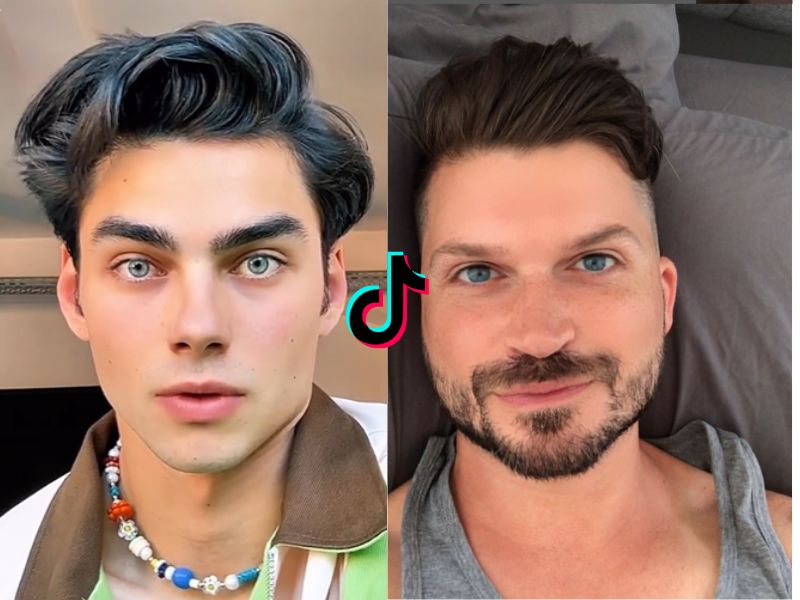
The influence of blue eyes on perception is explored in TikTok’s latest eye color experiment. Users have been utilizing a filter to change their eye color to blue and recording themselves with an identical expression. The theory behind this trend suggests that blue eyes create a more intense and intimidating stare. Despite the lack of scientific evidence, the trend has gained significant traction on TikTok, with millions of views.
This phenomenon has sparked discussions and debates, with users expressing their opinions and experiences related to eye color. Stay tuned to learn more about the societal impact and implications of this eye color experiment.
The TikTok Trend: Changing Eye Color to Blue
TikTokers are actively participating in a trend where they change their eye color to blue using a filter. This trend has gained popularity among mainly Gen Z users on the social media platform.
The theory behind this trend revolves around the perception that blue eyes appear more intimidating. Users with darker-colored eyes film themselves with the same expression and then use a realistic filter to change their eye color to blue. Despite the same expression, the blue eyes create an intense stare. TikTokers with blue eyes have reported that people tend to avoid eye contact with them.
However, it is important to note that there is no scientific evidence supporting this theory. Nevertheless, the trend continues to gain millions of views on TikTok, sparking discussions and debates about societal judgments based on eye color.
Testing the Theory: Blue Eyes and Perceived Intimidation
Participants in the experiment with varying eye colors have reported that when their eyes were changed to a specific shade of blue, they noticed a significant increase in the perception of intimidation from others.
TikTok users have been engaging in a trend where they change their eye color to blue using a filter. Despite the lack of scientific evidence supporting the theory, many participants have shared their experiences of people avoiding eye contact with them after changing their eye color to blue.

This trend has sparked discussions and debates, highlighting the influence of social media on beauty standards and societal judgments based on appearance.
By experimenting with different eye colors, TikTokers aim to challenge stereotypes and raise awareness about biases related to eye color.
The popularity of this trend on TikTok showcases the power of viral content in shaping perception and influencing social awareness.
Lack of Scientific Evidence: Debunking the Blue Eye Theory
Scientists and researchers have found no conclusive evidence to support the theory that changing eye color to blue creates a more intimidating presence. Despite the popularity of the TikTok trend and the claims made by its participants, scientific accuracy does not back up the theory.
TikTokers who participate in the trend gain millions of views, but this does not change the fact that the theory is based on subjective perceptions and lacks factual basis. While the trend continues to gain popularity on TikTok, it is essential to recognize that it does not hold any scientific validity.
This lack of evidence highlights the influence of social media in spreading trends and theories, as well as the need for critical thinking and awareness when engaging with such content.
Social Impact and Discussions: Spreading Beauty Standards on TikTok
The ongoing discussions surrounding the blue eye theory on TikTok highlight the impact of social media on shaping beauty standards and promoting certain physical attributes.
Users on TikTok engage in conversations and debates about the theory, expressing their opinions and experiences related to eye color.
The popularity of the trend shows the power of viral content on the platform in influencing societal perceptions of beauty.
As users experiment with different eye colors to challenge stereotypes, the trend raises awareness about biases associated with eye color and encourages discussions on societal judgments based on appearance.
TikTok plays a significant role in spreading trends and theories, amplifying the influence of social media on shaping beauty standards and promoting certain physical attributes.
Challenging Stereotypes: Eye Color’s Influence on Perception
Challenging societal stereotypes, TikTokers on the platform are actively engaging in discussions and debates about the impact of different eye colors on people’s assumptions about personality.
Through videos and conversations, users are experimenting with changing their eye colors using filters to challenge the traditional beliefs associated with certain eye colors.
By showcasing themselves with different eye colors and sharing their experiences, they aim to break the stereotypes and biases related to eye color.
These discussions highlight the power of social media in shaping beauty standards and perception.
TikTok provides a platform for individuals to voice their opinions and challenge societal norms.




